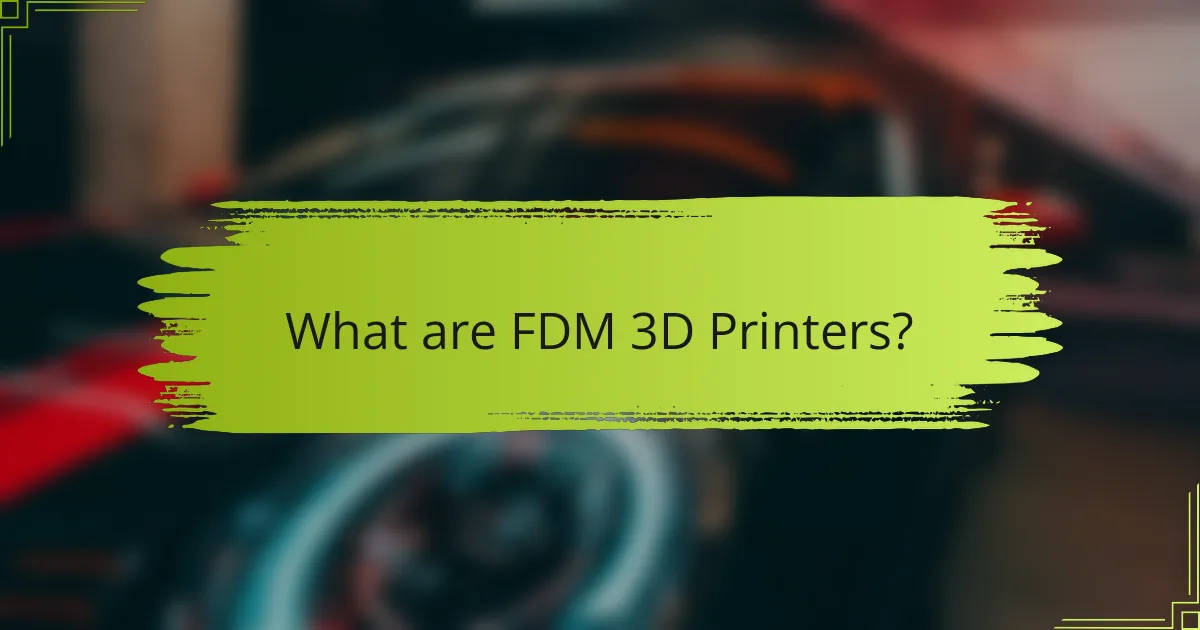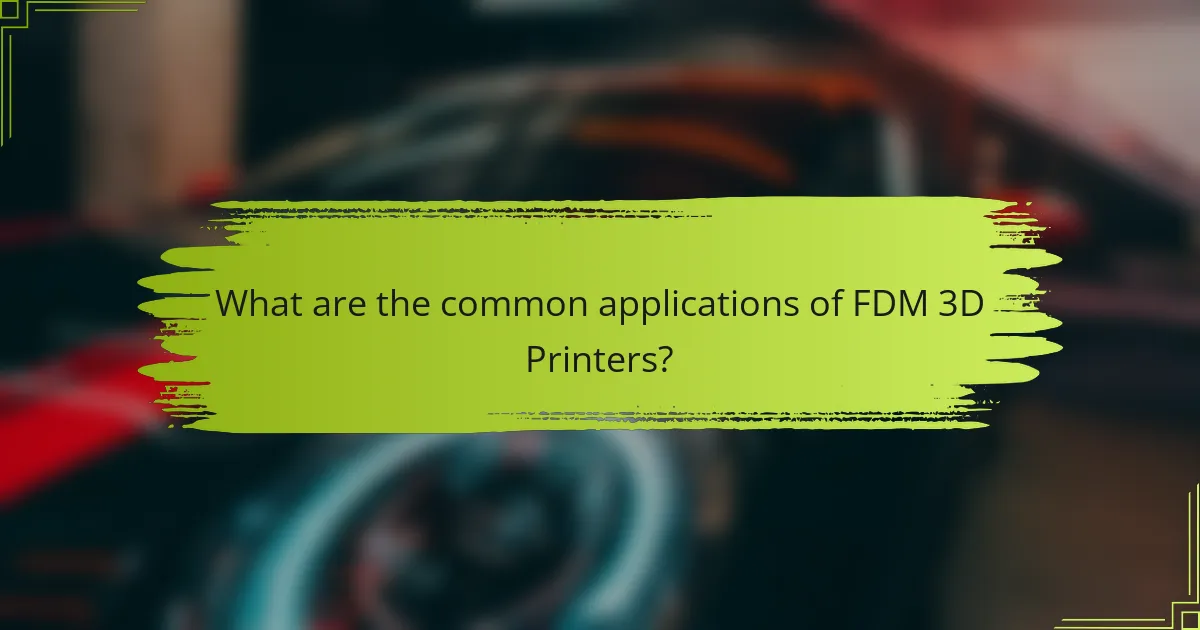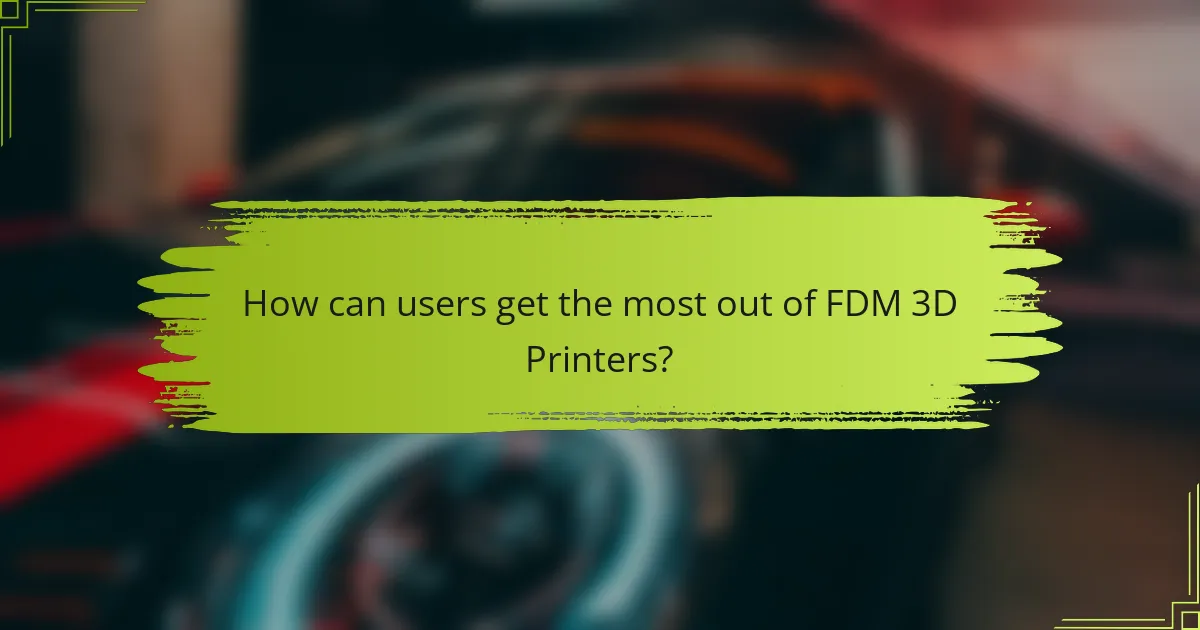
What are FDM 3D Printers?
FDM 3D printers, or Fused Deposition Modeling printers, are a type of additive manufacturing technology. They create objects by melting thermoplastic filaments and extruding them layer by layer. This process allows for the production of complex geometries and prototypes. FDM printers are widely used in various industries, including automotive, aerospace, and healthcare. They are popular for their affordability and ease of use. According to a report by Wohlers Associates, FDM technology represents a significant portion of the 3D printing market. This technology is suitable for both hobbyists and professionals.
How do FDM 3D Printers operate?
FDM 3D printers operate by extruding thermoplastic filament through a heated nozzle. The nozzle melts the filament as it moves along a defined path. This creates layers of material that build up to form a three-dimensional object. The printer follows a digital model, typically created in CAD software. Each layer is deposited on top of the previous one until the object is complete. The process involves a build platform that may move vertically as layers are added. Cooling fans often assist in solidifying the material quickly. Common materials used include PLA and ABS, which are popular due to their ease of use and availability.
What are the key components of an FDM 3D Printer?
The key components of an FDM 3D printer include the extruder, build platform, and control system. The extruder heats and deposits thermoplastic filament layer by layer. The build platform supports the printed object during fabrication. The control system manages the printer’s operations and coordinates movements. Additionally, the frame provides structural support for all components. The cooling system helps solidify the filament after extrusion. The filament spool holds the material used for printing. Each component plays a crucial role in the 3D printing process, ensuring accuracy and efficiency.
How does the extrusion process work in FDM printing?
The extrusion process in FDM printing involves melting thermoplastic filament and depositing it layer by layer. A heated nozzle melts the filament as it is fed through. The molten material is extruded onto the build platform. The nozzle moves according to the design, creating the object’s shape. As each layer is laid down, it cools and solidifies. This process continues until the entire object is formed. FDM printers typically use materials like PLA and ABS, which are widely available. The precision of the extrusion process affects the final quality of the printed object.
What materials are used in FDM 3D Printing?
Fused Deposition Modeling (FDM) 3D printing primarily uses thermoplastic materials. Common materials include PLA (Polylactic Acid), ABS (Acrylonitrile Butadiene Styrene), and PETG (Polyethylene Terephthalate Glycol). PLA is known for its ease of use and biodegradability. ABS offers higher strength and temperature resistance. PETG combines the best properties of both PLA and ABS, providing durability and flexibility. Other materials such as TPU (Thermoplastic Polyurethane) are also used for flexible applications. Each material has specific attributes that cater to different printing needs. For instance, PLA is suitable for beginners due to its forgiving nature, while ABS is preferred for functional parts requiring toughness.
What are the common filament types for FDM printers?
The common filament types for FDM printers include PLA, ABS, PETG, TPU, and Nylon. PLA, or polylactic acid, is biodegradable and easy to print. ABS, or acrylonitrile butadiene styrene, offers strength and heat resistance. PETG, or polyethylene terephthalate glycol-modified, combines ease of use with durability. TPU, or thermoplastic polyurethane, is flexible and ideal for elastic parts. Nylon is strong and suitable for functional prototypes. These filament types are widely used due to their distinct properties and applications in 3D printing.
How do material properties affect print quality?
Material properties significantly influence print quality in FDM 3D printing. The type of filament used determines adhesion, layer bonding, and surface finish. For instance, ABS offers good strength but can warp, affecting dimensional accuracy. PLA, on the other hand, provides excellent layer adhesion and a smooth finish.
Filament diameter consistency is crucial; variations can lead to inconsistent extrusion and surface defects. Temperature settings also impact print quality. Each material has a specific temperature range for optimal flow and adhesion.
Moreover, the material’s viscosity affects how well it flows through the nozzle. High-viscosity materials may result in under-extrusion, while low-viscosity filaments can cause over-extrusion.
Finally, the presence of additives in filaments can enhance properties like flexibility or UV resistance, further affecting the final print quality. These factors collectively demonstrate that material properties are essential for achieving desired outcomes in 3D printed objects.
What are the main advantages of using FDM 3D Printers?
FDM 3D printers offer several key advantages. They are cost-effective compared to other 3D printing technologies. The materials used, such as thermoplastics, are generally less expensive. FDM printers are also widely accessible, making them popular among hobbyists and professionals.
Their ease of use is another significant benefit. Most FDM printers have user-friendly interfaces and straightforward setup processes. Additionally, FDM printers support a variety of filament materials, providing flexibility for different applications.
They enable rapid prototyping, allowing for quick iterations in design. This speed can significantly reduce product development time. FDM printers also produce durable parts suitable for functional testing.
Finally, they feature a relatively low maintenance requirement. Regular upkeep is minimal, making them convenient for users. These advantages make FDM 3D printers a preferred choice in many industries.
How does cost-effectiveness play a role in FDM printing?
Cost-effectiveness is a significant factor in FDM printing due to its affordability and efficiency. FDM printers typically have lower initial costs compared to other 3D printing technologies. The materials used, such as thermoplastics, are generally inexpensive. This results in reduced operational expenses for businesses and hobbyists alike.
Additionally, the speed of FDM printing allows for quicker production times. This can lead to faster prototyping and reduced time-to-market for products. According to a study by Wohlers Associates, FDM technology has been shown to lower production costs by up to 50% in certain applications.
Overall, the combination of low material costs, affordable equipment, and efficient production makes FDM printing a cost-effective choice for many users.
What are the environmental benefits of FDM 3D Printing?
FDM 3D printing offers several environmental benefits. It reduces material waste compared to traditional manufacturing methods. Studies show that additive manufacturing can cut waste by up to 90%. FDM also utilizes thermoplastics, which can be recycled. This recycling capability minimizes landfill contributions. Additionally, FDM 3D printing can lower carbon footprints. It often requires less energy than conventional production techniques. A report indicated that 3D printing can reduce energy consumption by 50% in some applications. Overall, FDM 3D printing promotes sustainability through efficient material use and energy savings.

What are the common applications of FDM 3D Printers?
FDM 3D printers are commonly used in prototyping, manufacturing, and education. They create functional prototypes quickly and affordably. Industries like automotive and aerospace utilize FDM for testing designs. In healthcare, custom medical devices and anatomical models are produced. Educational institutions use FDM printers for hands-on learning in engineering and design. They also support hobbyists and makers in creating custom parts and models. FDM technology allows for rapid iteration and design modification. This flexibility is crucial in fast-paced development environments.
In which industries is FDM 3D Printing widely used?
FDM 3D printing is widely used in various industries, including aerospace, automotive, healthcare, and education. In the aerospace industry, it is utilized for prototyping and manufacturing lightweight components. The automotive sector employs FDM for rapid prototyping and production of custom parts. In healthcare, it is used to create patient-specific models and surgical guides. Educational institutions leverage FDM technology for teaching and research purposes. These applications demonstrate the versatility and efficiency of FDM 3D printing across multiple fields.
How is FDM printing utilized in prototyping?
FDM printing is utilized in prototyping by enabling rapid production of physical models from digital designs. This technology uses thermoplastic materials, which are extruded layer by layer to create a three-dimensional object. Prototyping with FDM allows for quick iterations and modifications, reducing the time from concept to final product. It is cost-effective compared to traditional manufacturing methods. FDM printers can produce complex geometries that are often difficult to achieve with other techniques. This method is widely used in industries such as automotive and aerospace for functional testing. Studies show that FDM prototypes can effectively simulate the final product’s performance.
What role does FDM printing play in manufacturing?
FDM printing plays a significant role in manufacturing by enabling rapid prototyping and production of complex geometries. This additive manufacturing technique uses thermoplastic materials to create parts layer by layer. It reduces material waste compared to traditional subtractive methods. FDM allows for customization and design flexibility, which is crucial for modern manufacturing needs. Industries like automotive and aerospace leverage FDM for cost-effective and efficient production. Studies have shown that FDM can decrease lead times significantly, enhancing overall productivity. The ability to produce lightweight components is another advantage, improving performance in various applications.
What are some innovative uses of FDM 3D Printers?
FDM 3D printers are used innovatively in various fields. They create custom prosthetics tailored to individual needs. This technology reduces costs and time for medical applications. FDM printers also produce complex geometries for aerospace components. These parts often have weight-saving designs that enhance performance. In education, FDM printers facilitate hands-on learning experiences. They enable students to prototype and iterate designs quickly. Additionally, FDM printers are utilized in construction for building models. They can also print entire structures using advanced materials. These innovative applications demonstrate the versatility of FDM 3D printing technology.
How is FDM technology impacting education and research?
FDM technology is significantly impacting education and research by enhancing hands-on learning and facilitating rapid prototyping. It allows students to create complex designs and physical models, promoting creativity and innovation. In research, FDM enables the production of custom tools and components quickly and affordably. This technology supports interdisciplinary collaboration by providing tangible solutions across various fields. Studies show that institutions utilizing FDM technology report improved student engagement and understanding of complex concepts. Furthermore, FDM printers are becoming increasingly accessible, making them valuable resources for educational institutions.
What are some creative projects completed with FDM printers?
Creative projects completed with FDM printers include custom figurines, intricate jewelry, and functional prototypes. Artists often use FDM technology to create unique sculptures and art pieces. Designers produce customized phone cases and household items with precise dimensions. Educational institutions utilize FDM printers for hands-on learning projects, such as building models. Engineers develop complex mechanical parts and tools for testing. Hobbyists create board game pieces and miniature models for tabletop games. Additionally, FDM printers are used to produce replacement parts for appliances and vehicles. These projects showcase the versatility and accessibility of FDM printing technology.

How can users get the most out of FDM 3D Printers?
Users can get the most out of FDM 3D printers by optimizing print settings. Adjusting layer height improves print quality and speed. Selecting the right filament enhances durability and appearance. Maintaining a clean print bed ensures better adhesion. Calibrating the printer regularly prevents common issues like warping. Using supports and rafts can help with complex geometries. Experimenting with different temperatures can fine-tune material flow. Lastly, utilizing slicing software effectively maximizes printing efficiency. Each of these practices contributes to achieving superior results with FDM 3D printers.
What are best practices for maintaining FDM 3D Printers?
Regularly clean the nozzle to prevent clogs. Use a soft brush or a cleaning filament to remove residue. Check and level the print bed before each print. This ensures proper adhesion and print quality. Lubricate the moving parts periodically to maintain smooth operation. Use a suitable lubricant recommended by the manufacturer. Monitor the filament feed for tangles or jams. This prevents printing issues and ensures consistent material flow. Inspect the printer for loose screws or components. Tightening them can enhance stability and performance. Lastly, update the firmware regularly to benefit from improvements and bug fixes.
How can users troubleshoot common issues with FDM printers?
Users can troubleshoot common issues with FDM printers by following systematic steps. First, check the printer’s power supply and connections to ensure it is operational. Next, examine the filament for clogs or jams in the extruder. Cleaning the nozzle can resolve many extrusion problems. Additionally, verify that the bed is level and clean to ensure proper adhesion. Adjusting the temperature settings for the filament type can also help with printing issues. Users should inspect the print settings in the slicer software for accuracy. If prints are warping, consider using a heated bed or adjusting the cooling settings. Regular maintenance, such as lubricating moving parts, can prevent future issues.
What tips can enhance print quality and efficiency?
To enhance print quality and efficiency in FDM 3D printers, calibrate the printer regularly. Proper calibration ensures accurate dimensions and layer adhesion. Use high-quality filament that is compatible with the printer. Quality filament reduces issues like clogging and inconsistent extrusion. Maintain a clean print bed to improve adhesion and reduce warping. A clean surface allows for better first-layer bonding. Optimize print settings such as temperature and speed based on the material used. Correct settings prevent problems like stringing and poor layer bonding. Regularly check and maintain the printer’s mechanical components. This includes lubricating moving parts and tightening loose screws. These practices lead to consistent performance and higher print quality.
What future trends can we expect in FDM 3D Printing?
Future trends in FDM 3D printing include increased material diversity and improved printing speeds. Advancements in thermoplastic materials will enable the use of composites and bio-based filaments. Enhanced print resolution will lead to finer details and smoother finishes. Automation and AI integration will streamline the printing process and reduce human error. Sustainability will drive the development of eco-friendly materials and recycling methods. Multi-material printing will allow for more complex designs and functional parts. The market is expected to grow significantly, with a projected CAGR of 20% from 2021 to 2026. These trends indicate a shift towards more efficient, versatile, and environmentally conscious FDM 3D printing technologies.
How is technology evolving in the field of FDM printing?
Technology in the field of FDM printing is evolving through advancements in materials, precision, and speed. New filament materials, such as carbon fiber and flexible thermoplastics, enhance the strength and versatility of printed objects. Innovations in nozzle design improve extrusion accuracy and reduce clogging. Multi-material printing allows for complex geometries and color variations in a single print. Software developments enable better slicing algorithms, optimizing print paths for efficiency. Additionally, the integration of AI in print monitoring enhances quality control during the printing process. These advancements collectively contribute to more reliable and efficient FDM printing solutions.
What advancements are being made in materials for FDM printing?
Advancements in materials for FDM printing include the development of high-performance thermoplastics. These materials offer improved strength, heat resistance, and flexibility. Notable examples are polyether ether ketone (PEEK) and polyphenylsulfone (PPSU). Innovations also extend to composite filaments, which combine plastics with carbon fibers or metal particles. These composites enhance mechanical properties and reduce weight. Biodegradable materials, such as PLA blends, are gaining traction for environmentally friendly printing. Researchers are also exploring new formulations to enhance adhesion and reduce warping. Recent studies indicate that these advancements significantly broaden the application scope of FDM printing.
FDM 3D printers, or Fused Deposition Modeling printers, are a widely used type of additive manufacturing technology that create objects by extruding melted thermoplastic filaments layer by layer. This article provides an overview of FDM printers, detailing their operational mechanics, key components, and common materials used, such as PLA and ABS. It highlights the advantages of FDM printing, including cost-effectiveness, ease of use, and environmental benefits, alongside its applications across various industries like automotive, aerospace, and healthcare. Additionally, the article explores best practices for maintenance and troubleshooting, as well as future trends and advancements in FDM printing technology.